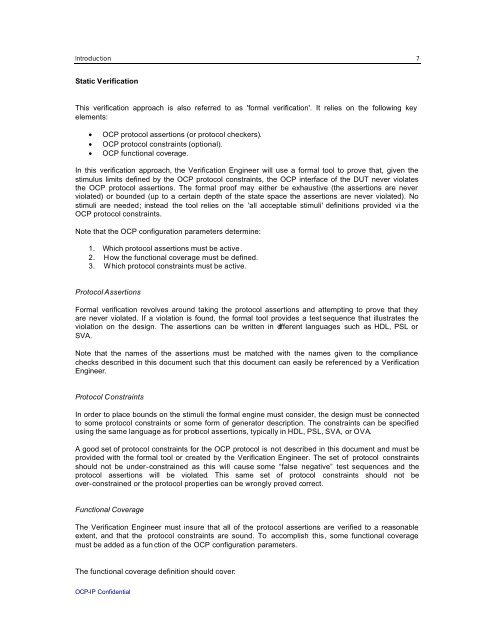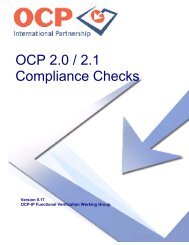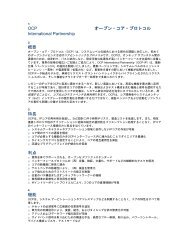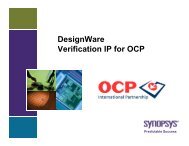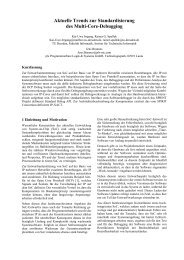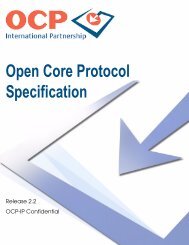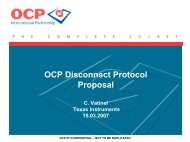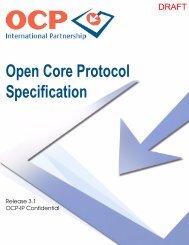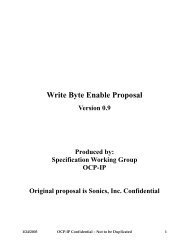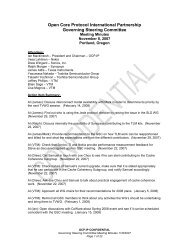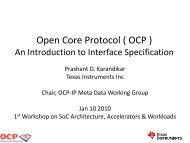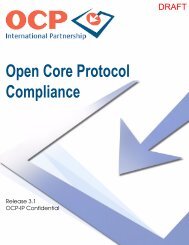OCP Comliance Checks_101905 - OCP-IP
OCP Comliance Checks_101905 - OCP-IP
OCP Comliance Checks_101905 - OCP-IP
Create successful ePaper yourself
Turn your PDF publications into a flip-book with our unique Google optimized e-Paper software.
Introduction 7Static VerificationThis verification approach is also referred to as 'formal verification'. It relies on the following keyelements:• <strong>OCP</strong> protocol assertions (or protocol checkers).• <strong>OCP</strong> protocol constraints (optional).• <strong>OCP</strong> functional coverage.In this verification approach, the Verification Engineer will use a formal tool to prove that, given thestimulus limits defined by the <strong>OCP</strong> protocol constraints, the <strong>OCP</strong> interface of the DUT never violatesthe <strong>OCP</strong> protocol assertions. The formal proof may either be exhaustive (the assertions are neverviolated) or bounded (up to a certain depth of the state space the assertions are never violated). Nostimuli are needed; instead the tool relies on the 'all acceptable stimuli' definitions provided vi a the<strong>OCP</strong> protocol constraints.Note that the <strong>OCP</strong> configuration parameters determine:1. Which protocol assertions must be active.2. How the functional coverage must be defined.3. Which protocol constraints must be active.Protocol AssertionsFormal verification revolves around taking the protocol assertions and attempting to prove that theyare never violated. If a violation is found, the formal tool provides a test sequence that illustrates theviolation on the design. The assertions can be written in different languages such as HDL, PSL orSVA.Note that the names of the assertions must be matched with the names given to the compliancechecks described in this document such that this document can easily be referenced by a VerificationEngineer.Protocol ConstraintsIn order to place bounds on the stimuli the formal engine must consider, the design must be connectedto some protocol constraints or some form of generator description. The constraints can be specifiedusing the same language as for protocol assertions, typically in HDL, PSL, SVA, or OVA.A good set of protocol constraints for the <strong>OCP</strong> protocol is not described in this document and must beprovided with the formal tool or created by the Verification Engineer. The set of protocol constraintsshould not be under-constrained as this will cause some “false negative” test sequences and theprotocol assertions will be violated. This same set of protocol constraints should not beover-constrained or the protocol properties can be wrongly proved correct.Functional CoverageThe Verification Engineer must insure that all of the protocol assertions are verified to a reasonableextent, and that the protocol constraints are sound. To accomplish this, some functional coveragemust be added as a fun ction of the <strong>OCP</strong> configuration parameters.The functional coverage definition should cover:<strong>OCP</strong>-<strong>IP</strong> Confidential


